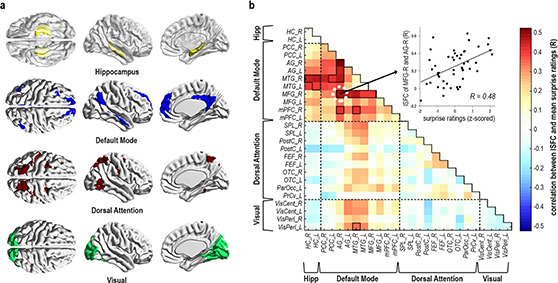More:
News & Stories
Brain Re-Update - Is a Surprising Moment Captured in the Memory Network?
A novel study led by Dr. Erez Simony, a brain researcher from the Faculty of Engineering and a guest scientist at the Weizmann Institute’s Department of Neurobiology, has advanced our understanding of the how the Default Mode Network of the brain works.

Dr. Erez Simony
The study, conducted in collaboration with Weizmann colleagues Prof. Rafi Malach and Post-Doctoral Fellow Dr. Talia Brandman, culminated in an article published in the new issue of the prestigious journal Nature - Communications Biology entitled : "The Surprising Role of the Default Mode Network in Naturalistic Perception". The article deals with the cerebral response of the default network during surprising moments and the means by which it is connected to prediction and memory patterns.
Imagine for a moment that you are watching a movie and suddenly a plot twist occurs. What happens in the brain at this exact moment? It turns out that the moment of surprise connects the near past with the present and future. But how? A leading theory in brain research asserts that our brain is constantly predicting the future. Just as when we hear a song and the words or melody play in our heads automatically, the same thing occurs while watching a movie. We are preoccupied with what is going to happen next. When an event happens contrary to our predictions, however, a surprise occurs and we are actually linking our prediction to the (wrong) future, the near past and what actually occurred. We are trying to reconcile the contradiction between them.
Where does this process transpire in the brain?
It turns out that this process takes place in several areas of the brain simultaneously. Of particular interest is the Default Mode Network, one of the most researched and fascinating networks of our brain. The Default Mode Network is a system of brain regions that usually respond together and are active in introspective and memory processes such as contemplation, past recollection, future planning, prediction and social construction. However, the role of this network’s functionality with information coming from outside is still unclear.
In the study, subjects were shown movies while imaging their brain activity with an MRI machine. The default network was examined in accordance with a variety of components of the perception and processing experience of the plot.

Graph: The default network while activated by surprise moments and communications with memory zones.
During the study, characteristics such as the degree of surprise (plot twist), recall and emotional arousal for each event in the film were rated, so that for each of these characteristics a graph of cognitive change was tracked over the time of viewing. The graph of cognitive changes was tested against the graph showing a brain reaction in the default network, as well as other brain systems.
The results demonstrated that the response of the default network alone clearly matched the degree of surprise throughout the film, i.e. the experience of being wrong in plot prediction (plot development differed from what the subjects expected), while communicating with brain regions important for memory and prediction. Moreover, in the most surprising moments in the film, the network regions responded more synchronously, or more simultaneously, than at other moments.
The findings of the study point to the important role of the default network in updating plot and memory prediction which occurs when there is a ‘mismatch’ between perception of reality and new external information. The researchers concluded that at a surprising moment in the plot contrary to our prediction and knowledge at that time, the default system activates a process which resolves the contradiction and updates our inner world.
In light of the fact that the default network regions are among the first to be affected by Alzheimer’s disease, the study opens up future possibilities for diagnosing memory problems by examining the relationship between plot surprise moments and activation of brain memory regions via the default network.
Read the full article online >>
Posted: 26/01/2021
- News & Events
New Collaboration with Sheba Medical Center will qualify nurses to work in a digital environment.
Collaboration between HIT Holon Institute of Technology, the teaching authority of the Sheba Medical Center, and the Sheba-BEYOND virtual hospital will allow training nurses in Israel and around the world to work in a digital...



 Additional programs
Additional programs
